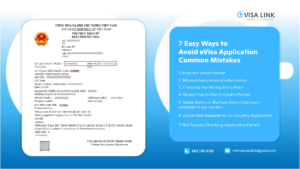Vietnam eVisa (short for Vietnam Electronic Visa) is always held in high esteem among foreign travelers with its convenience, cost-effectiveness with 90-day validity unlike the traditional, lengthy application process. Although applying for eVisa with ease within a few minutes, only a minor misstep could lead to a rejected visa or even a canceled trip to Vietnam.
However, this article highlights 7 crucial mistakes to avoid when applying for your Vietnam eVisa, alleviating any potential incidents during your trip to Vietnam.
Vietnam eVisa common mistakes
Incorrect photo format
First and foremost, the most common mistake lies in the incorrect photo format that slows down your eVisa applications. Here’s what you need to know of valid photos:
- Prepare two separate photos: You’ll need a clear, recent portrait photo (less than 6 months old) and a full-page scan of your passport’s information page (including the ICAO lines). Don’t crop the image from your passport!
- Format matters: Both photos should be in JPG, JPEG and GIF format, clear, and less than 2MB in size.
- Upload correctly: Make sure to upload the right photo in each field (portrait first, passport biodata page second) to prevent any delays for your Vietnam eVisa.
Mismatched personal information
Moreover, inaccurate personal information also happens regularly among Vietnam eVisa applicants and to avoid it, there are some notable things that you should take a look at:
- Name: When filling out your Vietnam eVisa application, prioritize precision. Enter your full legal name, including middle names (if applicable), exactly as it appears on your passport’s ICAO line, with correct spelling and spacing and remember to avoid any abbreviations.
- Date of birth: While you might be used to a different order, Vietnam eVisa applications require your date of birth in DD/MM/YYYY format.
- Passport-related information: For a smooth eVisa process, make sure you enter all the digits from your passport number and the exact date your passport expires.
Choosing the wrong entry point
Remember that Vietnam eVisas are only valid for entry at specific airports and land borders. Make sure to choose an entry point that accepts eVisas when booking your flights and ground transportation.
| Airports | Landports | Seaports |
| Noi Bai Airport (Hanoi) | Tay Trang Border Gate (Dien Bien) | Hon Gai Seaport (Quang Ninh) |
| Tan Son Nhat Airport (Ho Chi Minh City) | Mong Cai Border Gate (Quang Ninh) | Cam Pha Seaport (Quang Ninh) |
| Cam Ranh Airport (Khanh Hoa) | Huu Nghi Border Gate (Lang Son) | Hai Phong Seaport (Hai Phong) |
| Da Nang Airport (Da Nang) | Lao Cai Border Gate (Lao Cai) | Vung Ang Seaport (Ha Tinh) |
| Cat Bi Airport (Hai Phong) | Na Meo Border Gate (Thanh Hoa) | Chan May Seaport (Thua Thien Hue) |
| Can Tho Airport (Can Tho) | Nam Can Border Gate (Nghe An) | Da Nang Seaport (Da Nang) |
| Phu Quoc Airport (Kien Giang) | Cau Treo Border Gate (Ha Tinh) | Nha Trang Seaport (Khanh Hoa) |
| Phu Bai Airport (Thua Thien Hue) | Cha Lo Border Gate (Quang Binh) | Quy Nhon Seaport (Binh Dinh) |
| Van Don Airport (Quang Ninh) | La Lay Border Gate (Quang Tri) | Dung Quat Seaport (Quang Ngai) |
| Tho Xuan Airport (Thanh Hoa) | Lao Bao Border Gate (Quang Tri) | Vung Tau Seaport (Ba Ria-Vung Tau) |
| Dong Hoi Airport (Quang Binh) | Bo Y Border Gate (Kon Tum) | Ho Chi Minh City Seaport (Ho Chi Minh City) |
| Phu Cat Airport (Binh Dinh) | Moc Bai Border Gate (Tay Ninh) | Duong Dong Seaport (Kien Giang) |
| Lien Khuong Airport (Lam Dong) | Xa Mat Border Gate (Tay Ninh) | |
| Tinh Bien Border Gate (An Giang) | ||
| Vinh Xuong Land and Waterway Border Gate (An Giang) | ||
| Ha Tien Border Gate (Kien Giang) |
Neglecting to check validity period
Many travelers misunderstand Vietnam eVisa that becomes active upon arrival, therefore some of those travelers arriving close to the expiry date, resulting in a shorter stay than intended and potentially demand applying for a visa extension to remain in the country for a longer period.
Single Entry vs. Multiple Entry confusion
Planning a trip to Vietnam and unsure which eVisa to choose? A common confusion arises between Single Entry and Multiple Entry options. Here’s a quick breakdown:
- Single Entry: Perfect for a straightforward visit to Vietnam. This eVisa allows you to enter the country once within the validity period up to 90 days and exit without the possibility of re-entering.
- Multiple Entry: Ideal for travelers planning multiple entries to Vietnam during their trip, perhaps for side excursions to neighboring countries. This eVisa allows for multiple entries and exits within the validity period of 90 days.
eVisas not available for in-country applications
The Vietnam eVisa is a convenient option for hassle-free arrival, but there’s one crucial detail to remember: you can only apply for it when you’re outside of Vietnam. While some foreigners try to submit an eVisa application from within the country to do a “visa run” and extend their stay; unfortunately, these applications are always rejected.
Otherwise, we offer an Emergency Vietnam eVisa service to expedite the process and get you back to Vietnam as soon as possible.
Not double-checking application details
The aforementioned mistakes are sometimes inevitable, thus it’s crucial to review your Vietnam eVisa details carefully once you receive it. This simple step can save you time and money compared to facing delays or even denial at the airport on departure day. Here’s what you can do:
- Identify errors: When you download your eVisa, take a moment to verify all the information matches your passport exactly.
- Take action: If you find any discrepancies, act quickly! You can usually apply for a new eVisa and potentially reschedule your flight before your departure date. This will be much cheaper and less stressful than dealing with a rejected eVisa at the airport.
Some essential tips for your Vietnam eVisa to avoid mistakes
Ensure accurate information when filling eVisa form:
- Personal information: including name, passport details, nationality, DOB, etc.
- Plan your trip: Purpose of visit, arrival/departure dates, and port of entry.
- Valid passport: Must be valid 6+ months before your Vietnam entry.
- Photo check: Follow eVisa photo criteria (size, resolution, background).
- Final review: Before finalizing, double-check all information to see whether it is accurate or not.
Use Vietnam Visa link service:
In Vietnam Visa link, we offer a service to help you with every step of the process to ensure all details are accurate and understanding the requirements can save you time and hassle:
- We double-check all your information, such as name, date of birth, passport details, and nationality, to minimize the risk of errors.
- We keep you informed of regular updates on your eVisa application status.
- Get prompt and helpful support if any problems encounter with your eVisa.


